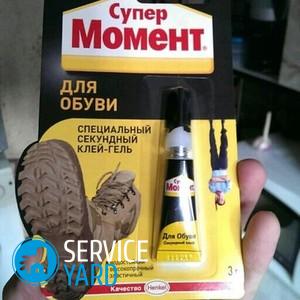Shoe glue

Probably everyone knows the problem when your favorite boots or shoes begin to fall apart literally before our eyes. In addition to mechanical damage, other causes of shoe damage can be mentioned - precipitation, aggressive chemicals that generously sprinkle sidewalks in winter ice, poor-quality sizing and much more. Today we’ll talk about how to choose and use the glue for shoes, how to effectively and quietly seal damaged areas yourself.
to contents ↑Where to start, or which shoe glue is better?
Before deciding in favor of a particular brand of glue for shoes, the following should be considered:
- Location of damage.
- The material from which the shoes are made. This is especially important because the molecular structure of different materials is different.
- Quality factor, durability of gluing. If you plan to bring this pair to the end of the season, then you can use an inexpensive and easy to use composition. If the shoes, in general, are still not bad, you can use the adhesive composition, which will restore the integrity of the material for another year or two.
- Moisture resistance. Each type of glue has its own moisture resistance threshold. If we are talking about winter boots or boots, you need to choose a more moisture-resistant composition.
- UV resistant. This factor is relevant for shoes that are worn in the summer.
- Elasticity. It is important that the glued seam does not crack. If you use hard glue, which, solidifying, becomes hard, then the issue of repairing shoes will soon become relevant again.
- Value for money. The cost of glue of a particular brand depends on the composition. Therefore, among the many proposals you need to look for the best in terms of acceptable cost and good quality connections.
What glue is better to glue shoes? Sole
So, do you think you can do the job yourself? What glue to choose if the sole on the shoe bursts? Or if the top is damaged?
Practice shows that polyurethane-based compounds are the best option for the sole. Polyurethane can withstand significant changes in air temperature, chemically neutral and, most importantly, very effective.
Consider the most popular polyurethane products.
“Desmokol” - waterproof adhesive for shoes
Moisture-proof composition on a polyurethane basis. Provides a high-quality adhesive joint (transparent, without color). Great for gluing soles, as well as gluing leather or textile tops to polyurethane or rubber soles. This glue is highly durable.
Important! Due to the significant increase in volume during use, Desmokol can be used when working with porous materials.
“Moment” - polyurethane adhesive for shoes
This is a universal adhesive composition that can be used for a variety of surfaces: wood, rubber, textile, leather. Moreover, it glues materials of different stiffness equally well - from the softest to the toughest. The glue line is durable and transparent.
to contents ↑Important! The composition is resistant to aggressive environments, high and low temperatures.
The best shoe glue for the top
The bonding requirements for the top are quick drying and minimal expansion.
“Nairit”
Universal polychloroprene adhesive, which perfectly holds together natural and artificial leather, as well as textiles. Using the “Nairit” compound, you can glue the top to a rubber or leather sole. It is also possible to use the composition when gluing insoles, installing elastic elements or linings.
Important! The disadvantage of this shoe glue is that it is not very effective at connecting the top with a polyurethane sole.
“Eva”
This is a universal tool for repairing the top, soles and attaching the top to the sole. The glue is waterproof, great for sealing joints.
to contents ↑Shoe repair tips at home
If you do not have enough experience in the shoe business, the recommendations of a professional will help you:
- Before gluing surfaces, clean them from dirt.
- A prerequisite is to dry the shoes before any repairs, otherwise - gluing will not be of high quality.
- The surfaces to be bonded must be degreased first using ethyl alcohol or an inexpensive cologne.
- The number of layers of adhesive applied is strictly individual. This applies to the characteristics of the adhesive and the strength of the seam that you want to achieve. Most often, one or two layers are sufficient.
- In order for the joint to be strong, the surfaces must be combined. Therefore, prepare the clips (they can be ordinary clothespins).
- The complete drying time for different types of glue is different, but it is better to withstand the day.
to contents ↑Important! The more pressing force you give to the surfaces, the better the gluing will result.
Stock footage
We hope that you have received from the review all the information on self-repair of shoes. Now you know with what glue to glue the sole of the shoe, and with which - the top. Of course, it is better to buy products from well-known brands - they are more solid, but no one is safe from accidental damage.
- How to choose a vacuum cleaner taking into account the characteristics of the house and coatings?
- What to look for when choosing a water delivery
- How to quickly create comfort at home - tips for housewives
- How to choose the perfect TV - useful tips
- What to look for when choosing blinds
- What should be running shoes?
- What useful things can you buy in a hardware store
- Iphone 11 pro max review
- Than iPhone is better than Android smartphones



